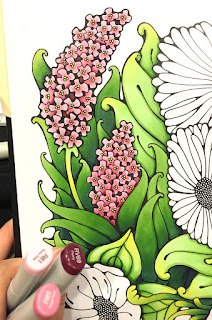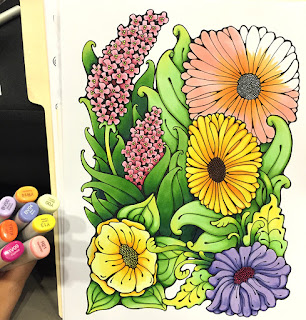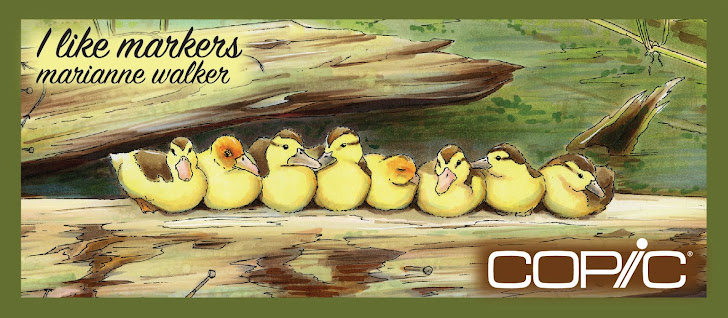Working with a limited color range
This weekend I was at an event and I had a chance to color one of the flowers coloring pages I drew this Summer. It really is a relaxing way to pass time, working on a larger project for a few hours.
I drew this image for our Coloring Flowers Line Art Pack. The images in our image packs are printed on the nice Art Paper we use in the Copic Sketchbooks.
Anyways, I was coloring on a folder on my lap, and I had only a limited color set with me. Even with few colors, I was still able to have a lot of fun coloring with depth. I wanted to share the power of having only a few greens and how you can add extra depth to your coloring.
As you can see, these kinda large, goofy flowers have a lot of different foliage in them. But with a limited range of greens, how could I create more color variety?
I had only YG11, YG13, YG17, and G28 for my green families. So, I had to pull out my Y13 to add some additional brightness to the leaves up front.
Base color changes everything
The color you choose as a base makes a huge difference when you are working with layers of light colors. Evenly soak your base color by coloring in circles, using the side of the brush nib on your Sketch or Ciao marker.
If you look at the flower on the bottom left, it had a base of YG11, with yellow added on top. The flower on the right I colored in reverse, with the base of Y13, and the YG11 was added to the top. I shadowed each leaf with YG13 and hints of YG17.
I wanted to make a layered look, with the viewer being able to easily pick out the leaves in front, then the other leaves fading into the background a bit more. However, I still wanted the viewer to feel that the leaves were from different varieties of plants, even though I had limited colors.
 Here is the rest of the leaf area, colored with only Y13, YG11, YG13, YG17, and darkest areas colored with G28.
Here is the rest of the leaf area, colored with only Y13, YG11, YG13, YG17, and darkest areas colored with G28.Extra details
If you look closely at the side-by-side comparison, you'll notice some subtle finishing touches that add extra depth and interest to the image. the image on the right has extra layers of color around the edges and veins on the leaves. Basically, on each leaf, I took the color that is one step darker than the base color of that area and accented edges, veins, shadows, etc.
 Here is a close up from the finished picture to show you what I mean. Look at how the extra green edges on the yellow leaves really accent them and make them more striking. (For the final area, I did end up needing to make my dark green area darker, but without another green, I ended up adding some faint hints of deep B39 into the shadows. )
Here is a close up from the finished picture to show you what I mean. Look at how the extra green edges on the yellow leaves really accent them and make them more striking. (For the final area, I did end up needing to make my dark green area darker, but without another green, I ended up adding some faint hints of deep B39 into the shadows. )I spent way too much time fussing over the leaves, probably 2-3 hrs on the leaves alone...except that I was at an event and constantly being interrupted to answer people's questions, so maybe it only took an hour or so of continuous time.
 Then I moved on to coloring the rest of the flowers in the picture. Remember, I had only a few colors, so the pink flowers were colored with R81, R85, and RV69. The centers were colored with Y13.
Then I moved on to coloring the rest of the flowers in the picture. Remember, I had only a few colors, so the pink flowers were colored with R81, R85, and RV69. The centers were colored with Y13.The two yellow flowers were colored with Y00, Y13, and YR14 and YR18 for the deep shadows (I used more YR14 and 18 on the darker yellow-orange flower).
The purple flower was colored with BV00 and BV04. The center is colored with RV09.
The top, coral-colored flower was colored with a base blend of YR14 and R21. If you look at the bottom image, you can see how the YR14 was flicked out from the center, about half way across the petals. The tips were left white. If they hadn't been left white then the R21 overlay would have been lost in the base orange.
 R21 was brought in from the tips and colored back into the darker YR14. To darken the shadows and edges of the petals on the coral flower, I used more layers of YR14 as well as YR18 and hints of RV69.
R21 was brought in from the tips and colored back into the darker YR14. To darken the shadows and edges of the petals on the coral flower, I used more layers of YR14 as well as YR18 and hints of RV69.Overall, I love how different this came out than most of my other work. It was a lot of fun! Now, it will promptly find a happy place in my portfolio.









